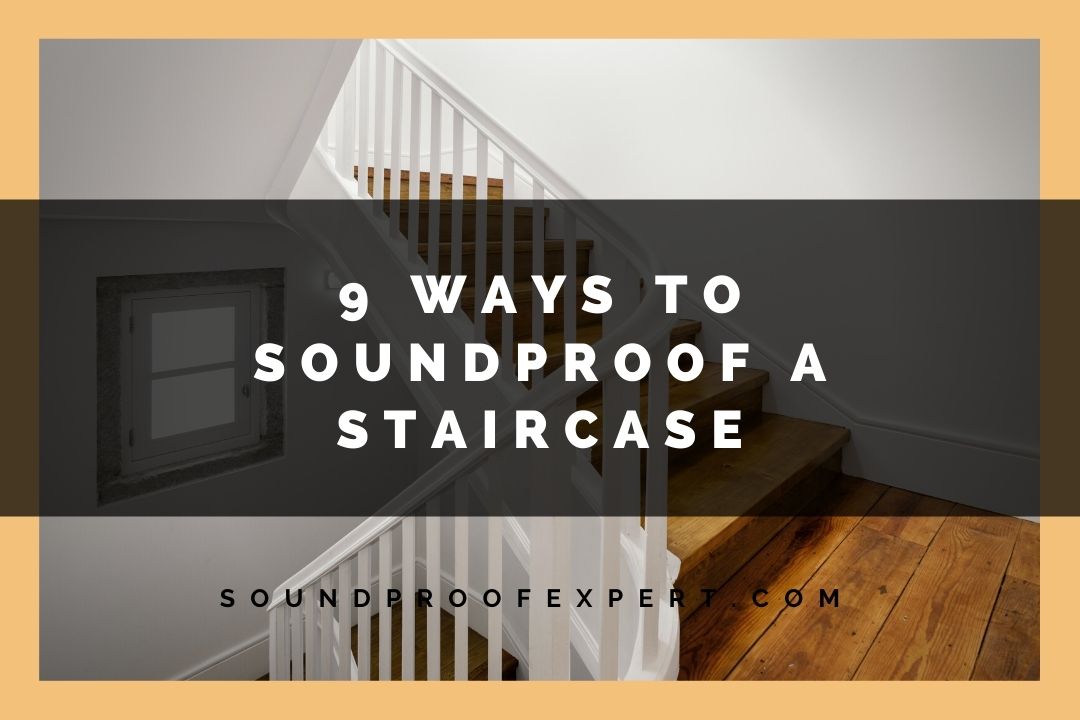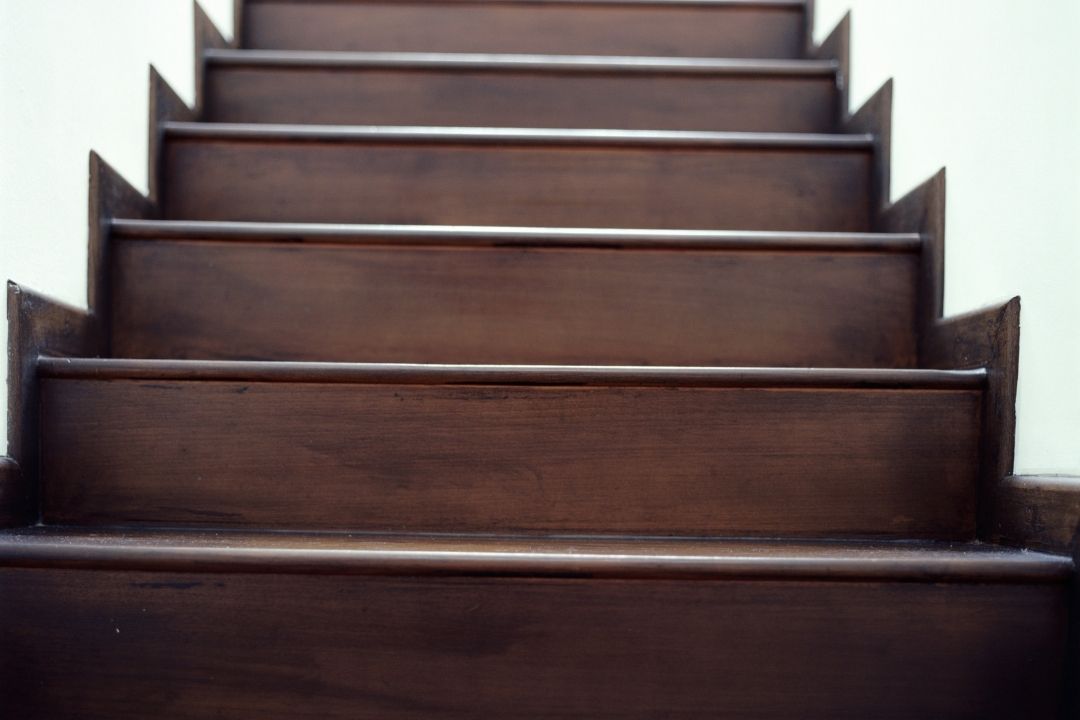
Are you tired of your creaky staircase making noise every time someone walks up or down the stairs? It can be frustrating living with this disturbance, especially when someone decides to make a trip during the middle of the night.
Fortunately, there are things you can do to silence your stairs and bring peace to you and the rest of the people in your home.
Continue reading to learn how you can soundproof your staircase. We’ll also include a few recommended products you can use to get the job done as efficiently and effectively as possible.
Silencing Your Staircase: A Step-by-Step Guide
There are several steps involved when you’re trying to soundproof a staircase in your home. Keep in mind that each staircase’s construction is different, so results may vary. Here are nine steps you can take to finally enjoy a quieter staircase:
1. Evaluate Your Stairs
First, you should take a walk up and down your stairs and note any specific places you hear creaking, squeaking, or another type of noise. Often, the stair treads (the boards that make each step) separate from the stringers (the supporting boards used to make the treads sturdy).
If this is the case, you’ll want to look for gaps or holes. If you find some, we recommend patching them up with a high-quality soundproof sealant or compound.
2. Add Insulation Surrounding Your Staircase
Insulation plays a crucial role in soundproofing a staircase, as it creates a thick barrier between floors and rooms that can help prevent noise. There are many different types of insulation available. Fiberglass, mineral wool, spray foam, and cellulose are four of the most popular insulations out there today. Pink foam is also a crowd favorite, offering moisture-resistant and durable material.
3. Cover and Cushion with Carpet
Probably one of the easiest things to do is to install carpet coverings on your steps along with some cork material underneath as an underlay. Doing this will help cushion the impact of your foot hitting each step, ultimately resulting in less noise. And not to mention making the up or down journey more comfortable for your feet.
The thicker the carpet, the more noise control you’ll most likely have. Simply measure and cut the strips of cork and carpet and staple or tape them down onto each step.
4. Install an Acoustic Underlay
Don’t worry if the carpet and cork method doesn’t work. There’s still hope! Adding a reputable acoustic underlay can be a solution to your irritating noise problem.
These underlays consist of several spongy layers that add comfort and impressive noise reduction, making for a quiet night’s rest or a peaceful day at home. An acoustic underlay is an excellent option if you’re working with hardwood flooring, as it reduces vibrations and sounds, absorbs moisture, and offers additional insulation.
5. Coat the Walls with Soundproof Paint
Did you know that soundproofing can be as simple as adding a coat of paint? You can purchase special soundproofing paint to do the job. This is an incredibly thick paint that takes around 72 hours to dry. The benefits are great if you can manage to wait that long.
This type of paint is water-based, like standard paint, but it uses latex as its main ingredient. The latex allows it to plug up any holes in the walls lining the staircase. After all, rubber is a rockstar insulator. It makes sense why it’d be used in this scenario.
Although this technique can be useful, it may not prevent all noise. That’s why we’d recommend using soundproof paint alongside another one of the products and methods mentioned throughout this article.
6. Soundproof the Walls
The walls around your staircase may be what’s causing all the commotion. Try soundproofing your walls using specially made acoustic paneling. These panels absorb noise and reduce sound transmission from wall to wall. You can purchase these soundproof panels in various sizes and densities.
Overall, remember that the goal is to increase the wall’s mass. Why? Because the higher the density, the less sound can get through.
On the other hand, you can also add an extra layer of drywall to add another sound-reducing barrier. Mass-loaded vinyl is a great material for this task.
7. Lubricate Your Steps
Many stair boards are connected, one horizontal and one vertical. Over time, these stair boards can start to rub together. This rubbing may be the cause of the squeaking and creaking that you’re hearing.

An easy fix is to apply some top-grade lubricant between each board (just like you would add WD-40 to a squeaking bolt in a door). We’d recommend using any of the following lubricants: talcum powder, powdered soapstone, or powdered graphite.
8. Use Your Furniture
Many homeowners are unaware of their furniture’s power when it comes to soundproofing. Whether you know it or not, your favorite rocking chair or your comfy couch plays an important role in the acoustics of your living room, offering beneficial sound absorption.
However, staircases usually aren’t placed next to a bunch of furniture. And this is partially why it seems like every single person in your house can hear every time you go upstairs.
Although we know it isn’t exactly plausible to move your couch next to your staircase, we would suggest moving a heavy piece of furniture closer to the bottom of the stairs. You can do this in your basement. Doing so can significantly dampen, if not eliminate, the noise you’re experiencing.
9. Support the Tread
Nothing lasts forever, and the same goes for the tread on your stairs. Normal wear and tear can reshape your tread throughout the years, causing excessive noise when someone ascends or descends.
A simple solution is to support the warped tread by adding a piece of wood underneath your stairs. All you have to do is measure your tread and cut a board according to that measurement. Once you have your panel, line one side of it with glue or another type of adhesive.
Next, firmly press the board against the stringer (or riser, depending on what type of staircase you have). Finally, take a few nails or screws and secure the board.
Conclusion
Although noise reduction is a common household problem, it doesn’t have to be for you anymore! We understand the frustrations of hearing every step resound throughout your house at all hours of the day. And we certainly acknowledge the nerves that accompany a trip downstairs after putting the baby down for a nap.
As you can see, there are a variety of simple things you can do to prevent your stairs from disrupting your precious sleep or your daily activities. Keep in mind that soundproofing doesn’t stop at your staircase. There are plenty of sound silencing techniques you can try in the rest of your home.
Now that you know all the required steps, you can start soundproofing your staircase. Do you have any questions, comments, or concerns? We’d love to hear your thoughts! Leave us a message below.
